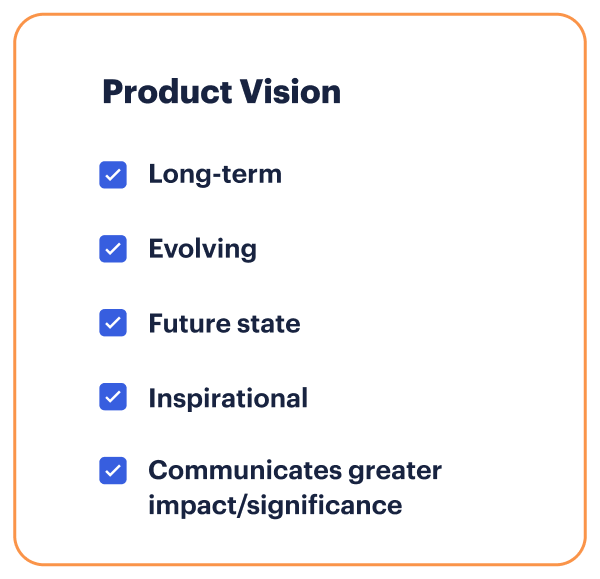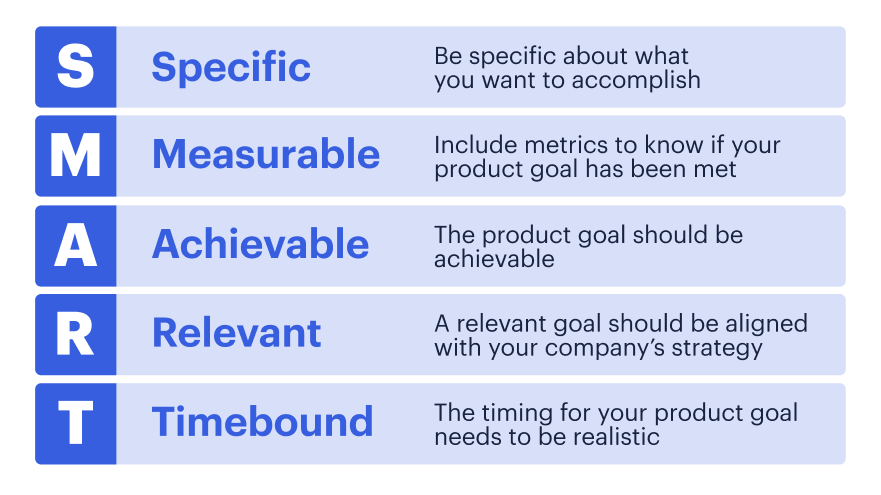Learn about purchasing for teams
What Are Product Goals in Scrum?

Reviewed by Madhur Kathuria
It’s essential for scrum teams to understand the strategic direction of the product they’re working on to prioritize the right work at the right time. A product goal allows teams to focus on meaningful work and measurable success metrics.
In 2020, the product goal became an official part of the Scrum Guide based on feedback that teams were too focused on sprints and didn’t have enough insight into the longer-term strategy of the product. By setting a product goal, scrum teams become important players in driving the success and growth of their product.
A product goal is a written statement that helps guide the team in choosing the right priorities for the product and is an integral part of the scrum framework.
The Importance of Product Goals
By setting clear and specific product goals, the scrum team and stakeholders align on where the product is headed. One of the values of scrum is focus, and a product goal allows everyone to focus on what they agree is the most crucial goal for the product.
Decision-making and prioritization become crystal clear with agreement from both the scrum team and the product stakeholders on what success looks like. A path to success reveals itself when you set a product goal that's transparent to everyone.
Another benefit of the product goal is that it provides clear prioritization to the team, which in turn supports quality and predictability while building trust between the team and stakeholders.
How the Goal Differs From the Product Vision
While a product vision is the long-term, ever-evolving description of the desired future state of the product, a product goal is a more mid-term goal for the product. It gives the scrum team something tangible to aim for and plan against. You may have several product goals on the path to fulfilling the vision, and the vision itself often evolves and changes with time.
Product visions are:

Who Is Responsible for the Product Goal?
The Scrum Guide tells us that the product owner is accountable for product backlog management, which includes "developing and explicitly communicating" product goals. So, while the PO is accountable for these goals, they may—and often do—work with the rest of the scrum team to develop and define the goals together. They may delegate aspects of developing that goal to others. It will look a little different depending on your context and organization, but the product owner is ultimately accountable for the goal.
What Are Some Examples of the Types of Product Goals?
The product goals in scrum can vary a lot from company to company. They could really be within any job function or domain. Below, we look at four common types of product goals: revenue, user acquisition, technical, and customer satisfaction.
Setting a Revenue Goal
A revenue goal focuses on increasing sales or improving profitability. For example, let’s say that your scrum team is working at the corporate headquarters of a fast food chain. The company is launching a new line of vegetarian options. Your scrum team is developing a website for this product. Here’s an example of a revenue goal:
“To sell $200k from this new food category during the first three months after the launch.”
Setting an Acquisition Goal
An acquisition goal focuses on promoting products to a new audience and acquiring new customers. Using the same fast food vegetarian product line example, here’s what an acquisition goal looks like:
“Acquire 200 new customers from sales of vegetarian menu items in Q1.”
Setting a Technical Goal
Technical goals focus on improving technical aspects of a product or making progress on something technical. These goals support product quality.
"Optimize the system's performance by reducing response times for critical functionalities by 30%."
Setting a Customer Satisfaction Goal
A customer satisfaction goal is all about improving customer satisfaction with your product. Here’s an example of one for the same line of vegetarian items from the fast food restaurant:
“Improve our restaurant’s overall star rating on Google from 4.2 to 4.8 in Q1 with the addition of our new product line offering.”
Setting SMART Goals

When writing a product goal, the SMART framework is a popular technique. This acronym stands for Specific, Measurable, Achievable, Relevant and Time-Bound. Let’s take a deeper dive into each of these.
Setting a Specific Product Goal
When setting a goal, be specific about what you want to accomplish. A specific product goal considers the who, what, when, and why.
Think about who you need to involve with the work, such as specific team members or stakeholders. Be extremely detailed in what you’re trying to accomplish. Determine when the goal should be met. Does the product have a specific timeline—such as a delivery date or a product launch behind it? Understand the why behind the goal. Why is this important to the product?
Making Your Product Goal Measurable
You’ll need to include metrics to know if your product goal has been met. If the metrics are lagging indicators, set milestones along the way so you can track progress and keep stakeholders informed.
Creating an Achievable Product Goal
The product goal is meant to be inspiring, so it should be achievable, or else the scrum team may get discouraged. If your team doesn’t have the skills or tools to attain the goal, think about how you will acquire them.
Writing a Relevant Product Goal
A relevant goal should be aligned with your company’s strategy. If you’re launching a new product, the product goal should feed into larger business objectives. Your scrum team may be able to launch a new B2B product, but if your company is focused solely on the consumer market, that wouldn’t be a relevant goal.
Setting a Time-Bound Product Goal
The timing for your product goal needs to be realistic. If you don’t set a timeframe, you won’t have any way to measure success. If the product goal is three months from now, determine what major milestones are needed to achieve your goal along the way.
Here’s an example of a SMART goal:
Description: Improving customer experience on our website is a key business priority this year, so we will refresh our eCommerce experience. By the end of the year, there should be a 10% increase in purchases from our website. We’ll build the new website in-house but will use an agency for initial user experience testing.
Milestones:
- Complete user experience testing in Q1.
- Soft launch to beta group of employees in Q2.
- Launch the new shopping cart feature in Q3.
- Fully rebranded site with improved functionality in Q4.
Deadline: End of the fiscal year.
Creating Actionable Product Goals
The product goal is a great way to keep your team focused on the work that needs to be accomplished. However, a product goal is very high-level, so you’ll need to break it down into bite-sized chunks, which the scrum framework does well!
Let’s think about the shopping cart feature used in the above example. Hold a brainstorming session where the scrum team can ideate on all the work needed to build that feature. The outputs of that session can then become product backlog items, which the team’s product owner can prioritize.
Measuring and Tracking Product Goals
The scrum team must measure progress toward the product goals to know if they’re on track and to be transparent about the progress with product stakeholders.
Breaking down product goals into sprint goals is a way to get more granular with what the team will accomplish in a short amount of time. They should tie directly to the product goal.
There are several ways to measure and track your progress. Let’s say that after you release the new shopping cart feature, you expect a 5% bump in purchases over the coming quarter. By knowing pre-existing sales numbers, the team can track the next quarter's numbers from the website and make a comparison. The 5% increase is an early indicator that the overall site revamp will help you obtain your product goal of 10 percent more sales.
The sprint review meeting is a great time to share progress with key stakeholders and make any adjustments to timelines or expectations.
Deliver Better Customer Solutions With Product Goals
Working on a scrum team isn’t just about product delivery—it’s about creating products that align with the goals of your business. By setting product goals, your scrum team can show its success in a meaningful way. Rather than being judged by story completion, which only measures outputs, your team can demonstrate real value to the business by delivering on product goals. Setting a product goal is easy, and there’s no better time to start than now.
If you’re a product owner who wants to continue to grow your agile skills and become more competitive in your field, see the courses available to you in our product owner track.











